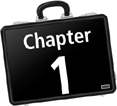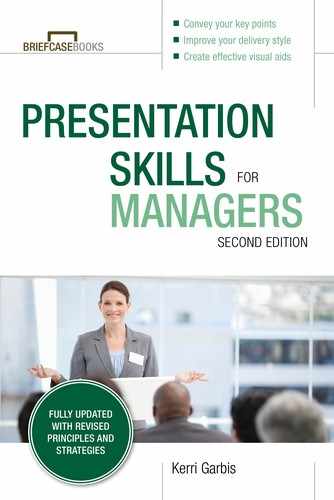
The Rehearsal Process
I hope that you’ll read this whole book and that you find numerous ideas and techniques that you can apply to your own presentations. But if you were to read only one chapter (and I’m not advocating that), this is the one to read. The reason is that nearly everything I have to offer you incorporates what I’m going to explain in the next few pages.
This chapter is about the Rehearsal Process, the method every actor uses in some way and has done since theater began. The Rehearsal Process is the bridge between good material and a great presentation. It is the link between the purely academic and the experiential. It gets your content out of your notes and into your body. Presentations don’t happen on the page. They happen on a stage.
The material in this book is relatively easy to understand intellectually. You can read all of it, put it down, and say “Good, I got it.” But leaving it there isn’t going to work in any way toward making you a better presenter. Simply understanding what I’m saying isn’t the point. You’ve got to find a way to apply it.
The solution is to use the Rehearsal Process. Actors spend years finding what works for them individually, but the essence of the process remains the same. The idea behind the Rehearsal Process is that you become so familiar with your material, and the challenges posed by presenting it, that no matter what is thrown at you, you can still deliver in a professional way.
This process is also where you take the time to work on the fundamentals: the feet, the hands, the face, your vocal challenges, stage movement, and the rest. It’s where you find out what works and what doesn’t. In this regard, the Rehearsal Process actually influences content. Once you begin to lift your information off the page, it becomes clear very quickly what makes sense and what doesn’t, what has impact and what’s repetitive. Finding this out in the safety of rehearsal is much better than finding it out in front of an audience on the day of your presentation.
This technique has three steps: talk-through, walk-through, and dress rehearsal.
I encourage you to do each step more than once. Repetition of this process will help make all of your presentation choices second nature by building them into your muscle memory.
This is an overview—I want you to get a feel for how the process works on a very high level. There are a lot of specifics that you can work on in each step of the Rehearsal Process. They’re all covered in subsequent chapters. For now, get your mind used to thinking in these three steps.
The Talk-Through
On the first day of rehearsal for any play, the actors sit down with the director and simply read the entire play out loud. They just say all of the words the playwright wrote. Afterward they discuss, ask questions, and start the process of reading it again. This talking through of the play may occur multiple times before the actors ever get on their feet.
The first step of your Rehearsal Process is to simply talk through your presentation. Saying your content out loud helps you know what you actually mean. It gets you used to saying the words that will become your presentation. Your content doesn’t have to be a finished product at this point. It can simply be a collection of notes.
This isn’t about memorizing anything, but simply hearing it for the first time and getting a feel for what needs work. You may find that you need more content here and less there. Maybe you have too much content to fit the time you’ve been given (this is not uncommon). All this and more you can discover in your talk-through.
The Walk-Through
The second part of the Rehearsal Process is when you begin to put the material “on its feet.” This is when you stand up and start to experiment with movement and gestures. Armed with the knowledge from your talk-through, you can now start to discover the physical shape of your presentation. Where might you move? Why would you do so? How can you use movement to highlight your ideas? This is an opportunity to make some big choices. You also have the luxury of finding out which movements work and which ones don’t without any witnesses. You can work out all of your physical discomfort with presenting (Where do my hands go?) by yourself. At this point, your voice and articulators (I’ll talk more about them later ...) will have found their way around your content, and you can let your body get comfortable with bold movement that supports your message.
I’ll cover the nitty-gritty of stage movement, gestures, and more later in the book. For now, just know it’s important at this step in the process to get moving.
Dress Rehearsal
The third step is the opportunity to give your presentation exactly as you will on the day, only without an audience. The point is to use everything you’ve learned in the talk-through and walk-through, with the addition of all of the technical elements and the clothes you plan on wearing.
The ultimate goal of your dress rehearsal is to remove as many unknowns from your presentation as you possibly can. Really commit to doing this as you will in your final presentation. As with every point of the Rehearsal Process, this step doesn’t have to be “one and done.” It certainly can be if all you’ve got is one evening. However, you’re welcome to have as many dress rehearsals as you have time for! If your first one gives you some good ideas as to what you could change, and you want to go back and give yourself another dress rehearsal, do it. It can’t hurt.
The Rehearsal Process and You
By taking the time to do the talk-through, walk-through, and dress rehearsal, you’re ensuring that you’ve done everything you can to eliminate the unnecessary, to build on the good, and to make sure your fundamentals are working for you. You’ve gotten your presentation into your body so that you don’t have to think about every element of it while you’re presenting. As you continue to use it, I’m sure you’ll uncover some of the other benefits of the Rehearsal Process as well. It’s a great method for combating stage fright, for one thing.
There’s something else important about the Rehearsal Process that I’ll remind you of again and again throughout this book: the Rehearsal Process is time-flexible. So often, I hear people complain that they simply don’t have the time (or don’t want to make it) to practice their presentations. This is simply untrue. Whether you’ve got two days, two weeks, or two months, you can adjust this process timewise to work for you. Each rehearsal doesn’t have to take hours and hours, but it can if you have the time. On an extremely brief schedule, even giving each step a matter of minutes can make the difference.
That said, if you really want to improve, if you really want to present like a pro, you’ve got to put the time in. If you’ve got time to really go in depth with the Rehearsal Process, you absolutely should. Use it to your advantage. This is what makes the difference between average and outstanding presentations.
Don’t Quit Your Day Job
One summer, I worked at the Weathervane Theatre in Whitefield, New Hampshire. The theater presented its season of shows in repertoire, meaning every night, each week, the theater presented a different show or musical. This was great for the family whose vacation in the White Mountains only spanned a week. It was pretty tough on the actors who were rehearsing one, or possibly two shows during the day and performing another one at night. The only way I got through that summer was by executing a well-organized Rehearsal Process.
My point is, if I can take the time to rehearse and do my preparation work while performing another show or two, I know you can make time—even if it’s just a few minutes per day.
Can You Rehearse Too Much?
A lot of time dedicated to rehearsal, to some people, means their delivery will be inauthentic or boring. But rehearsal is not just mindless repetition or memorization of canned movements and vocal choices. It’s about experimenting to find what works best. If you rehearse by saying the same things over and over again and doing the same things over and over again, then, yes, you can rehearse too much. If you rehearse in a smart way that helps you improve with each talk-through, walk-through, or dress rehearsal, then you can never be overrehearsed.
I’m not asking you to become an actor. However, I am asking you to think like one. No actor I know would dream of taking the stage in a play or musical without some kind of rehearsal. To be a masterful presenter, neither should you.
Manager’s Checklist for Chapter 1
![]() Embrace the Rehearsal Process!
Embrace the Rehearsal Process!
![]() The talk-through
The talk-through
![]() Remember to say your presentation out loud.
Remember to say your presentation out loud.
![]() Your presentation content doesn’t have to be completely finalized.
Your presentation content doesn’t have to be completely finalized.
![]() Get used to saying the words and discovering what content works and what doesn’t.
Get used to saying the words and discovering what content works and what doesn’t.
![]() The walk-through
The walk-through
![]() Talk through your presentation on your feet.
Talk through your presentation on your feet.
![]() Experiment with stage movement, gestures, and more.
Experiment with stage movement, gestures, and more.
![]() Start to build muscle memory.
Start to build muscle memory.
![]() Dress rehearsal
Dress rehearsal
![]() The only thing absent from this rehearsal is the audience!
The only thing absent from this rehearsal is the audience!
![]() Use all of your visuals, your wardrobe, everything.
Use all of your visuals, your wardrobe, everything.
![]() Invite colleagues, if possible, for an extra outside opinion.
Invite colleagues, if possible, for an extra outside opinion.
![]() Remember, the Rehearsal Process is time-flexible. You can make it work for you!
Remember, the Rehearsal Process is time-flexible. You can make it work for you!
![]() Don’t fret about overrehearsing. Rehearse smart to keep things fresh.
Don’t fret about overrehearsing. Rehearse smart to keep things fresh.




